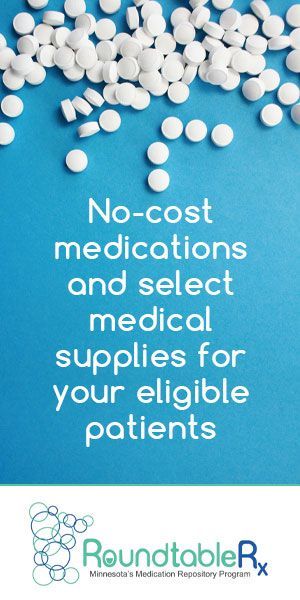s the season of Medicare renewals and open enrollment has just recently passed, many of your patients have made decisions about their health care coverage that directly impacted their medication costs. The choices were often overwhelming, even for full-time industry experts, but the good news is that a lot of people have gone through considerable effort to lower patient out-of-pocket costs and thereby improve health care overall. No one expects physicians to become experts in the many new options, what they replaced or how they came to be, but in the event patients bring these matters into the exam room this article will provide some insight into the scope and breadth of the issues.
Legislation
New Medicare Prescription Drug Savings
A look inside the new law
BY Cathy McLeer
A federal law enacted in 2022 is now helping nearly 1 million Minnesotans with Medicare save money on life-sustaining prescription medications. The new law requires Medicare to start negotiating the price of certain drugs, penalizes drug companies that increase their prices faster than inflation, caps seniors’ annual out-of-pocket costs for prescription drugs in Medicare Part D, and limits cost sharing for insulin in Medicare drug plans.
AARP fought for the passage of the new prescription drug law because high prescription drug prices are deeply personal for families and impact their day-to-day lives. Medications don’t work if you can’t afford them, yet one in five older adults report having to forego filling their prescriptions or skipping doses to save money on their medications. Far too many people choose between paying for life-sustaining medications they need and paying for food or rent.
The law represents a fundamental shift in how the U.S. approaches prescription drug pricing in Medicare and finally starts to hold drug companies accountable for their out-of-control prices. Here’s a quick rundown of the new benefits and protections that are already available and what’s still to come.
In Minnesota, 900,000 Medicare Part D enrollees can receive free recommended preventive vaccines.
Benefits That are Available Right Now
Insulin co-pays capped at $35/month. Co-pays for a 30-day supply of any plan-covered insulin are now capped in Medicare Part D, with similar limits on out-of-pocket costs for insulin covered under Medicare Part B. Part D plans are required to offer this co-pay amount even before you meet your deductible for the year. Prior to the new drug law, the average out-of-pocket cost for people with Medicare was more than $60 per insulin fill. It’s estimated that 1.5 million Medicare beneficiaries would have saved an average of $500 each if this new protection had been in place in 2020. In Minnesota alone, more than 27,000 Medicare enrollees save on average $672 dollars each year.
Free vaccines for Medicare beneficiaries. If you’re on Medicare, you no longer have to pay anything out-of-pocket for vaccines that are recommended for adults by the Advisory Committee on Immunization Practices (ACIP). This was an important change for Medicare Part D-covered vaccines that previously required cost sharing, such as shingles. Overall, 10.3 million enrollees received a Medicare Part D-covered vaccine with no cost sharing in 2023, representing about 20% of the total Part D population. In Minnesota, 900,000 Medicare Part D enrollees can receive free recommended preventive vaccines.
No cost sharing for catastrophic coverage in Part D. Under the original Part D benefit, once your out-of-pocket costs reached a certain threshold, you entered “catastrophic” coverage but were still responsible for 5% of your prescription drug costs, with no limit. In 2022, 1.5 million people in Medicare Part D prescription drug plans reached catastrophic coverage and had to continue paying 5% of their drug costs for the rest of the year, which sometimes meant paying thousands of dollars more. Now, people in Part D plans are not responsible for any out-of-pocket drug costs once they enter catastrophic coverage. This change is the first step of even bigger changes discussed below that will further limit annual out-of-pocket costs starting in 2025.
Expanded eligibility for Medicare Part D Extra Help. Medicare pays some or all of the out-of-pocket prescription drug costs for people with limited incomes and resources through the Extra Help program. This year, the income threshold for the full Extra Help benefit increased from 135 percent to 150 percent of the federal poverty level ($22,590 for a single person or $30,660 for a couple in 2024). This change improved access to affordable prescription drug coverage for nearly 300,000 individuals with Medicare, as well as an additional 3 million people who could benefit from Extra Help but aren’t currently enrolled.
Drug companies pay penalties for big price increases. Drug companies that increase the prices of their products faster than inflation must now pay the higher-than-inflation amount back to Medicare. For example, if inflation were 5%, and a drug price increased by 6%, the drug company has to pay the 1% difference for all Medicare-based sales of that drug back to Medicare. This provision addresses brand name drug companies’ long-standing practice of increasing their prices year after year, often at rates that are higher than inflation.
The nonpartisan Congressional Budget Office (CBO) expects the new penalties to reduce drug prices for Medicare and the commercial health care market, which will lead to lower premiums and out-of-pocket costs for millions of Americans.
Medicare Drug Price Negotiation Process Begins
The Department of Health and Human Services has launched a new annual process to identify the drugs Medicare spends the most money on and choose a subset of drugs for price negotiation. All of the selected drugs must be single source, meaning there is no generic or biosimilar competitor on the market, and the newest drugs on the market will not be eligible for negotiation. Drugs will be eligible for the two-year negotiation process only if it has been at least 7 years (for small molecule drugs) or 11 years (for biologic drugs) since they were approved by the U.S. Food & Drug Administration (FDA).
Federal officials have already announced the Medicare-negotiated prices for the first 10 drugs selected for the program. These include commonly prescribed blood thinners, medications that treat diabetes, heart failure, chronic kidney disease, Crohn’s disease, ulcerative colitis, rheumatoid arthritis, psoriasis and blood cancers.
The selected drugs are used by varying patient population sizes, and total per enrollee spending on the drugs ranges from $3,000 to nearly $130,000 per year, indicating that the selection process successfully identified drugs that are widely used and/or expensive. The final Medicare-negotiated prices for these first 10 drugs take effect on January 1, 2026, and will result in significant cost savings for 118,000 Minnesotans with Medicare Part D who take these drugs. Even more will benefit as prices for additional drugs are negotiated each year in the future.
The new $2,000 out-of-pocket limit will provide important new financial protection.
Keeping Health Insurance Affordable for Millions
In addition to the prescription drug-related provisions, the new law also helps adults under age 65 purchase affordable health insurance. The law provides ongoing financial assistance for adults with limited resources who purchase health insurance through state and federal exchanges. This assistance completely covers or lowers the costs of premiums for people with the lowest incomes and ensures that no one buying coverage on the exchanges pays more than 8.5 percent of their income toward premiums. Without this support, millions of Americans are at risk of losing their health coverage because they can no longer afford it – especially those who are 50 and older, who pay the highest rates (up to three times more) for their coverage. This financial assistance would have expired at the end of 2022 but is now available through 2025.
Cap on Annual Out-of-pocket Drug Costs and Part D Benefit Changes
Medicare Part D covers most of the prescription drugs that you pick up at the pharmacy. In 2025, the program will undergo several changes that will help reduce out-of-pocket costs. Most important, no one will have to pay any out-of-pocket costs for prescriptions once they hit an annual cap ($2,000 in 2025). There was previously no limit on how much a person on Part D could have to pay in a given year, and some Part D enrollees on expensive drugs faced out-of-pocket costs that exceeded $10,000 per year. The coverage gap where enrollees were originally responsible for 100% of their prescription drug costs (sometimes called the “donut hole”) will also be eliminated.
About 4.3 million people in Medicare Part D plans reached catastrophic coverage in 2022. Of them, about 1.5 million did not receive Extra Help and had to pay 5% of their prescription drug costs for the rest of the year, spending an average of nearly $3,100 out-of-pocket. The new $2,000 out-of-pocket limit will provide important new financial protection for these enrollees, as well as for anyone else in the program who is prescribed an expensive drug in the future. More than 40,000 Medicare Part D enrollees in Minnesota not receiving Extra Help are estimated to benefit from the new out-of-pocket cap.
Ability to Spread out-of-pocket Costs Out Over the Year
Medicare Part D plans must now offer people the option of “smoothed” cost sharing, which will allow them to spread their out-of-pocket costs over the course of the plan year. For example, someone on a very expensive drug who would otherwise have to pay $2,000 out-of-pocket in January 2025, reaching the new out-of-pocket limit, will instead be able to spread that $2,000 cost across 12 monthly payments. This mechanism will help protect people on expensive drugs from large out-of-pocket payments that may arise in a particular month and potentially improve their ability to afford their prescription medications.
People with Medicare Begin to Benefit from Medicare negotiated Drug Prices (2026)
Starting in 2026, anyone who gets a prescription for one of the 10 drugs negotiated this year will benefit from that new, negotiated price. The Department of Health and Human Services will add new drugs to the Medicare drug price negotiation process every year. Medicare is already negotiating for 10 drugs for prices that will become available in 2026 and will add up to 15 drugs in 2025 and 2026 for prices that will become available in 2027 and 2028, respectively. Starting in 2027, Medicare will add up to 20 drugs every year going forward for prices that will become available in 2029 and beyond. This means that as many as 60 drugs total could be selected and negotiated by 2029.
The Congressional Budget Office (CBO) expects Medicare drug price negotiation to lower the prices of selected drugs by roughly 50% on average and to reduce Medicare Part D enrollees’ out-of-pocket costs by $7 billion in 2031 alone.
Overall, the new drug law includes numerous provisions that have made historic improvements in the health and well-being of older Americans by making their prescription drugs more affordable. AARP worked for years supporting these changes and helping to push them across the finish line, and we will continue to work to ensure that this law is fully implemented and benefits older Americans for decades to come.
Our health care delivery system faces numerous challenges, particularly in serving older adults, who account for the greatest percentage of health care cost. Creating meaningful solutions to these challenges will take ongoing, concerted and coordinated effort from a wide range of stakeholders. The changes discussed in this article are examples of this kind of positive and proactive work. As the nation’s largest nonprofit, nonpartisan membership organization, AARP believes it’s outrageous that Americans pay as much as three times more for the same medications than people in other countries pay. The most common reason that older people skip medications or ration their medicines is that they can’t afford it. The Inflation Reduction Act is a historic first step in putting access to lifesaving cancer, diabetes and heart medications in reach for millions of older adults while also saving taxpayers billions of dollars. AARP knows the fight isn’t over and will continue to push back on efforts to weaken or undermine this law until all older Americans can afford their lifesaving medicine.
Cathy McLeer, is the state director of AARP Minnesota and submitted this article citing aarp.org as the source for the content.
MORE STORIES IN THIS ISSUE
cover story one
Maps of Healing: Rural Horizons of Tertiary Care
By Fateh Bazerbachi, MD
cover story two
Living with ADHD: Understanding and empowerment





































